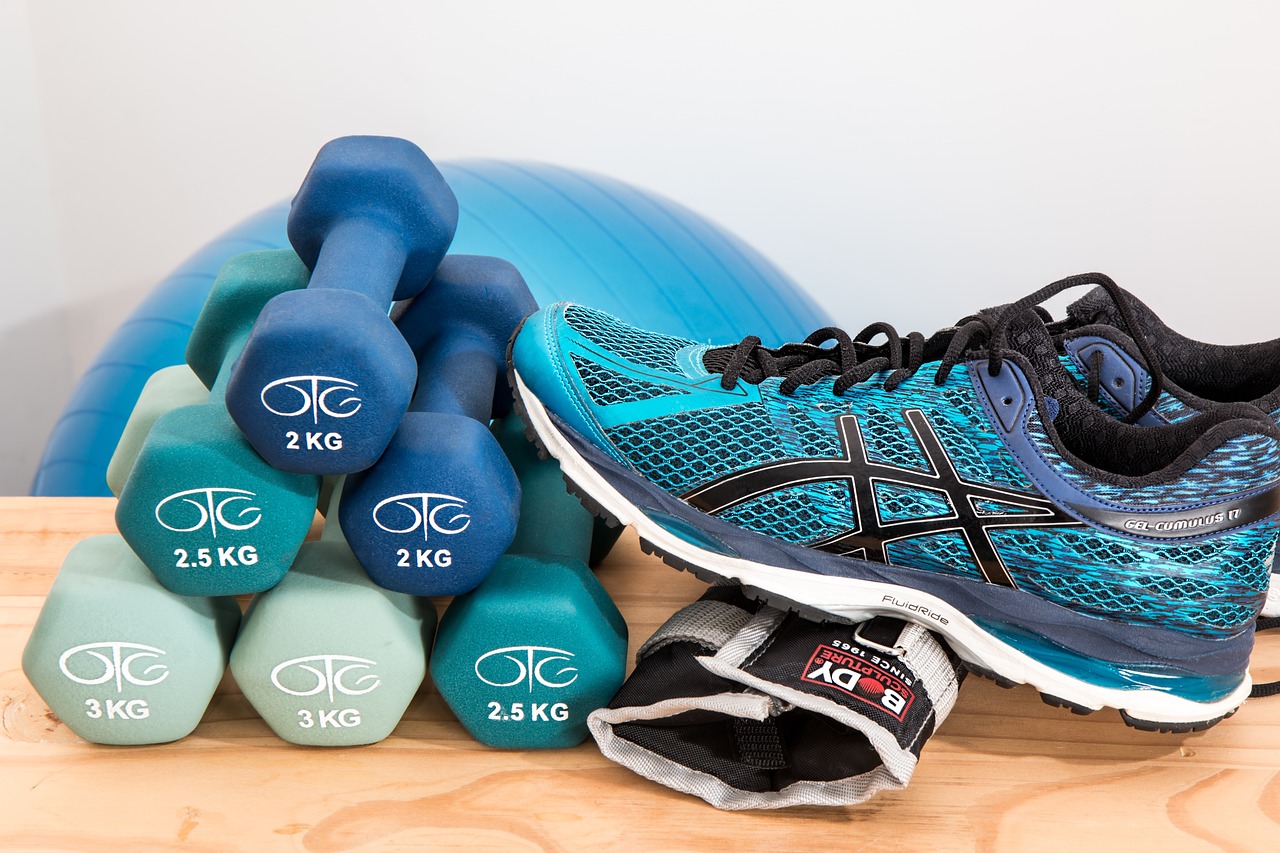How Mobile Apps are Changing Fitness Culture
In today's fast-paced world, where every second counts, the way we approach fitness has undergone a monumental shift, thanks to mobile applications. These apps have become more than just digital tools; they are now integral parts of our daily routines, shaping how we exercise, track progress, and engage with our health. Imagine having a personal trainer, nutritionist, and workout buddy all in your pocket! This is the reality that fitness apps offer, making fitness more accessible and engaging than ever before.
Over the past few years, fitness apps have surged in popularity, transforming the fitness landscape significantly. They provide users with a plethora of features, including personalized workout plans, tracking capabilities, and community support. With just a few taps on your smartphone, you can access a world of fitness resources that were once only available to those with gym memberships or personal trainers. This democratization of fitness means that anyone, regardless of their location or financial situation, can embark on a journey toward better health.
One of the most exciting aspects of fitness apps is how they harness the power of gamification and social features to enhance user motivation. Think about it: when was the last time you felt pumped to work out? Mobile apps create a sense of competition and achievement through challenges, leaderboards, and rewards. For instance, many apps allow users to participate in virtual challenges, where they can earn badges or points for completing workouts. This not only makes exercising more fun but also encourages individuals to stay committed to their fitness goals.
Fitness apps excel in providing tailored training programs based on individual preferences and fitness levels. Whether you’re a beginner looking to get off the couch or an experienced athlete aiming to break personal records, there’s an app that can cater to your specific needs. These personalized plans take into account factors like age, fitness level, and even equipment availability, making workouts more effective and enjoyable. It's like having a customized fitness coach guiding you every step of the way!
Many fitness apps are now equipped with features that allow for adaptive workouts. This means that as you progress, your app can adjust your workout in real-time, responding to your performance and feedback. For instance, if you’re finding a workout too easy, the app can increase the intensity or suggest alternative exercises to keep you challenged. This level of personalization ensures that you’re always working at your optimal level, maximizing your results.
Another significant advantage of fitness apps is their ability to track progress through detailed analytics. Users can monitor various metrics, such as calories burned, distance traveled, and workout duration. This data not only helps users stay motivated but also allows them to make informed adjustments to their fitness journey. By visualizing progress over time, individuals can celebrate their achievements and identify areas for improvement.
Fitness apps also foster a sense of community among users. Many platforms allow individuals to connect, share achievements, and support one another in their fitness endeavors. This social aspect can be incredibly motivating, as users can cheer each other on, share tips, and even compete against friends. Imagine the thrill of posting your workout results and receiving encouragement from your peers! It’s this sense of belonging that can make the difference between giving up and pushing through.
The integration of fitness apps with wearable devices has further enhanced tracking capabilities. Now, users can access comprehensive data on their health and performance, all in real-time. This synergy between apps and wearables enables a more holistic view of one’s fitness journey.
Wearable technology, when paired with fitness apps, offers real-time feedback, allowing users to make immediate adjustments to their workouts and health habits. For example, if your heart rate spikes during a workout, the app can notify you to slow down or take a break, ensuring that you stay within safe limits. This immediate feedback loop is crucial for optimizing performance and preventing injuries.
Many fitness apps come equipped with health monitoring features, such as heart rate tracking and calorie counting. These functionalities promote a more comprehensive approach to fitness and wellness. By keeping an eye on vital statistics, users can make informed decisions about their health, from adjusting their diets to altering workout intensities. It’s like having a personal health assistant right on your wrist!
As technology continues to evolve, the future of fitness apps looks incredibly promising. We can expect to see advanced features like AI coaching and virtual reality workouts becoming mainstream. These innovations will not only enhance user experiences but also further transform the fitness landscape, making workouts even more immersive and effective. Just imagine stepping into a virtual gym where you can train alongside friends from around the world!
- What are the best fitness apps available? There are numerous fitness apps available, including MyFitnessPal, Strava, and Nike Training Club, each catering to different fitness goals.
- Do fitness apps really help with motivation? Yes! Many fitness apps use gamification and community features to enhance motivation and encourage users to stick to their goals.
- Can I use fitness apps without a gym membership? Absolutely! Fitness apps provide a variety of workouts that can be done at home or outdoors, making them accessible to everyone.

The Rise of Fitness Apps
This article explores the transformative impact of mobile applications on fitness culture, highlighting trends, benefits, and the role of technology in promoting healthier lifestyles.
In recent years, fitness apps have exploded onto the scene, revolutionizing the way people approach their health and wellness. Gone are the days when you needed a personal trainer or a gym membership to get fit. Now, with just a few taps on your smartphone, you can access a plethora of resources designed to help you achieve your fitness goals. These apps offer a range of features, from personalized workout plans to nutrition tracking, making fitness more accessible than ever before.
Imagine waking up in the morning, checking your phone, and seeing a customized workout plan tailored specifically for you. That’s the magic of fitness apps! They provide users with the ability to create and follow personalized workout routines that cater to their individual preferences and fitness levels. Whether you're a beginner looking to lose weight or an experienced athlete aiming to push your limits, there's an app out there that can help you on your journey.
Moreover, the rise of these apps has been fueled by the increasing awareness of health and wellness in society. People are more conscious than ever about their physical condition, and they’re seeking convenient solutions to help them stay on track. According to a recent study, over 70% of fitness enthusiasts now use fitness apps to guide their workouts and monitor their progress. This surge in popularity can be attributed to several key factors:
- Accessibility: With smartphones in nearly every pocket, fitness apps are available to anyone, anywhere, at any time.
- Affordability: Many apps offer free versions or affordable subscription plans, making them a cost-effective alternative to traditional gym memberships.
- Variety: Users can choose from a wide range of workouts, including yoga, HIIT, strength training, and more, catering to diverse interests and fitness levels.
The community aspect of fitness apps cannot be overlooked either. Users can connect with friends, share their achievements, and even participate in virtual challenges. This sense of camaraderie fosters a supportive environment that encourages individuals to stay committed to their fitness journeys. It’s like having a workout buddy in your pocket, cheering you on every step of the way!
In conclusion, the rise of fitness apps has transformed the fitness landscape, making it easier for individuals to take charge of their health. With personalized plans, community support, and the convenience of mobile technology, it's no wonder that these apps have become a staple in the lives of fitness enthusiasts everywhere. As we continue to embrace this digital age, the future of fitness looks brighter than ever.
| Question | Answer |
|---|---|
| What are fitness apps? | Fitness apps are mobile applications designed to help users track their workouts, monitor their health, and achieve fitness goals. |
| Are fitness apps effective? | Yes, many users find fitness apps effective for providing structure, motivation, and personalized guidance for their workouts. |
| Do I need a gym membership to use fitness apps? | No, fitness apps can be used independently of a gym membership and often provide at-home workout options. |
| Can I track my nutrition with fitness apps? | Many fitness apps include nutrition tracking features to help users monitor their dietary intake alongside their workouts. |

Impact on Workout Motivation
In a world where staying fit can feel like an uphill battle, mobile apps have emerged as game-changers in workout motivation. Imagine waking up in the morning, feeling a bit sluggish, and then you grab your phone. With just a few taps, you have access to a virtual coach, a community of like-minded individuals, and a treasure trove of challenges waiting for you. These apps leverage the power of gamification and social interactions to create an environment that encourages users to commit to their fitness goals. It's not just about lifting weights or running laps anymore; it’s about engaging in a journey filled with rewards and recognition.
One of the most fascinating aspects of fitness apps is their ability to turn mundane workouts into exciting challenges. Users can participate in virtual races, compete with friends, or even join global fitness challenges. This element of competition creates a sense of urgency and excitement. Have you ever felt that rush when you see a leaderboard? That’s motivation at its finest! Fitness apps tap into our competitive nature, making us strive for better results, not just for ourselves, but also to outshine our peers.
Moreover, the social features of fitness apps cannot be overlooked. Many platforms allow users to connect with friends or join groups that share similar fitness goals. This sense of community fosters support and accountability. When you know that your friends are tracking their workouts and sharing their achievements, it inspires you to lace up your sneakers and hit the gym. It's like having a personal cheerleading squad right in your pocket.
But let’s not forget about personalized experiences. Fitness apps analyze user data to provide tailored workout plans and actionable insights. This means that instead of a one-size-fits-all approach, you receive a program that suits your individual needs and preferences. Imagine how motivating it is to see a workout plan designed just for you, taking into account your fitness level, goals, and even your favorite types of exercises. It’s like having a personal trainer, but without the hefty price tag!
Additionally, the concept of progress tracking is a significant motivator. Users can monitor their achievements through detailed analytics, including metrics like calories burned, distance covered, and workout frequency. This real-time feedback allows individuals to celebrate their milestones, no matter how small. For instance, seeing a graph that shows your improvement over weeks or months can be incredibly satisfying. It’s a visual reminder that all your hard work is paying off, and it encourages you to keep pushing forward.
To wrap it up, mobile apps have revolutionized the way we approach fitness motivation. By combining gamification, social engagement, personalized training, and progress tracking, these tools create an ecosystem that not only makes working out more enjoyable but also more effective. So, if you find yourself struggling to stay motivated, perhaps it’s time to explore the incredible world of fitness apps. They might just be the spark you need to ignite your fitness journey!
- How do fitness apps keep me motivated? Fitness apps use gamification, social features, and personalized training plans to keep users engaged and motivated.
- Can I use fitness apps without a gym membership? Absolutely! Many fitness apps offer home workout plans that require little to no equipment.
- Are fitness apps suitable for beginners? Yes! Most fitness apps provide customized plans that cater to all fitness levels, including beginners.
- Do I need wearable technology to use fitness apps? While wearable devices enhance tracking capabilities, many fitness apps can be used effectively without them.

Personalized Training Plans
In today's fast-paced world, where everyone seems to be juggling multiple responsibilities, finding the right workout routine can feel like searching for a needle in a haystack. This is where come into play, revolutionizing the way individuals approach fitness. Fitness apps have made it possible to create tailored workout programs that cater to a user's specific needs, preferences, and fitness levels. Imagine having a personal trainer right in your pocket, ready to guide you through every step of your fitness journey!
These personalized plans take into account various factors, such as your current fitness level, workout preferences, and even your goals—be it weight loss, muscle gain, or simply improving overall health. By analyzing this information, fitness apps can generate a customized workout schedule that keeps you engaged and motivated. This is not just a one-size-fits-all approach; it’s about crafting a unique path that resonates with you personally. For instance, if you prefer high-intensity interval training (HIIT) over traditional cardio, your app can prioritize workouts that align with that preference.
Moreover, the beauty of personalized training plans lies in their adaptability. Many apps use algorithms that adjust your workouts in real-time based on your performance. If you’re crushing your sets and feeling great, the app might increase the intensity or duration of your next workout. Conversely, if you’re struggling, it can dial back the difficulty to ensure you’re not overwhelmed. This dynamic adjustment is akin to having a personal coach who can read your energy levels and adapt your training on the fly.
| Feature | Description |
|---|---|
| Tailored Workouts | Workouts designed specifically for your fitness level and goals. |
| Real-Time Adjustments | Workouts that adapt based on your performance and feedback. |
| User Preferences | Incorporates your favorite types of exercises into your routine. |
Another fantastic aspect of personalized training plans is the progress tracking feature. Users can monitor their improvements over time, whether it’s tracking the number of push-ups completed or the distance run. This data not only serves as a motivational boost but also helps users make informed adjustments to their training. Seeing tangible results can be incredibly empowering, transforming the often daunting fitness journey into a series of achievable milestones.
In essence, personalized training plans provided by fitness apps are not just about creating a workout schedule; they are about building a holistic fitness experience. They foster a sense of ownership over your health and fitness journey, making it easier to stay committed and enthusiastic. So, the next time you think about hitting the gym or going for a run, consider how a personalized training plan could be the game-changer you need to elevate your fitness routine!
- What are personalized training plans? - These are customized workout schedules designed to meet an individual's specific fitness goals and preferences.
- How do fitness apps create these plans? - They analyze user data such as fitness levels, goals, and preferences to generate tailored workouts.
- Can personalized training plans adapt over time? - Yes, many apps adjust workouts in real-time based on user performance and feedback.
- Do I need any special equipment for these workouts? - Not necessarily! Many personalized plans can be adapted for home workouts or gym settings, depending on what you have available.

Adaptive Workouts
In the ever-evolving landscape of fitness, have emerged as a game-changer, revolutionizing how we approach our fitness routines. Imagine stepping into a gym or rolling out your yoga mat at home, only to have your workout automatically tailored to your current energy levels and performance. This is not a distant dream; it's the reality brought to you by cutting-edge fitness apps. These apps utilize advanced algorithms and real-time data to modify your workout on the fly, ensuring that you get the most out of every session.
How does this work, you might ask? Well, when you engage with an adaptive workout app, it collects data on your previous workouts, monitors your heart rate, and even assesses your fatigue levels. Based on this information, the app can adjust the intensity, duration, and type of exercises you perform. For instance, if you’re feeling particularly strong one day, the app might increase the weights or add more challenging exercises. Conversely, if you’re feeling a bit off, it can dial back the intensity or suggest a lighter workout. This flexibility not only keeps users engaged but also helps prevent injuries, as it encourages individuals to listen to their bodies.
Additionally, many fitness apps provide users with a visual representation of their progress, allowing them to see how their workouts are adapting over time. This feature can be incredibly motivating, as users can track improvements in strength, endurance, and overall fitness. For example, a user might start with basic bodyweight exercises and, as they progress, the app can introduce more complex movements or higher resistance levels, ensuring that the user is always challenged but never overwhelmed.
Moreover, the beauty of adaptive workouts lies in their ability to cater to a wide range of fitness levels. Whether you're a seasoned athlete or a complete beginner, these apps can create a workout plan that feels just right for you. This personalization fosters a sense of achievement, making it easier to stick to your fitness goals. You might find yourself asking, “How did I ever work out without this?” as you breeze through your sessions, feeling empowered and in control.
In summary, adaptive workouts are not just a trend; they represent the future of fitness. By leveraging technology, these apps provide a level of personalization and responsiveness that traditional workouts simply cannot offer. As we continue to embrace the digital age, it’s clear that fitness apps are leading the charge in making exercise more accessible, enjoyable, and effective for everyone.
- What are adaptive workouts? Adaptive workouts are personalized exercise routines that adjust in real-time based on your performance, energy levels, and feedback.
- How do fitness apps adapt workouts? Fitness apps use algorithms to analyze user data, such as heart rate and previous performance, to modify workout intensity and types of exercises.
- Are adaptive workouts suitable for beginners? Yes! Adaptive workouts cater to all fitness levels, making them ideal for both beginners and experienced athletes.
- Can I track my progress with adaptive workouts? Absolutely! Most fitness apps provide detailed analytics that allow you to monitor your progress over time.

Progress Tracking
Tracking your fitness progress is like having a personal cheerleader by your side, constantly reminding you of how far you've come and pushing you to reach new heights. With the advent of fitness apps, monitoring your journey has never been easier or more engaging. These applications come equipped with a plethora of features that allow users to log workouts, track nutrition, and analyze performance over time. Imagine being able to visualize your progress through detailed graphs and statistics—it's like having a treasure map that guides you toward your fitness goals!
One of the most exciting aspects of progress tracking is the ability to set specific, measurable goals. Whether you're aiming to run a 5K, lift a certain weight, or simply lose a few pounds, fitness apps enable you to break these goals down into achievable milestones. As you hit each milestone, the app rewards you with badges or notifications that celebrate your achievements, keeping you motivated and engaged. This gamification aspect not only enhances your experience but also instills a sense of accomplishment that fuels your desire to keep pushing forward.
Moreover, most fitness apps offer real-time analytics that provide insights into your performance. For instance, you can see how many calories you've burned during a workout, track your heart rate, or monitor your pace during a run. This immediate feedback allows you to make informed decisions on the fly. If you notice that your heart rate is too high, you can adjust your intensity accordingly. If you're not burning as many calories as you hoped, it might be time to tweak your routine. The power of data at your fingertips transforms the way you approach fitness, making it a more dynamic and responsive journey.
Additionally, many apps feature progress journals where users can jot down their thoughts, feelings, and reflections after each workout. This personal touch adds a layer of emotional engagement to the physical journey. It’s not just about numbers; it’s about how you feel and what you learn along the way. Such reflections can provide valuable insights into your motivations and challenges, helping you to stay on track and adjust your strategies as needed.
Lastly, the ability to share your progress with friends or within the app's community can significantly enhance your accountability. When you post your achievements and see others doing the same, it creates a supportive environment where everyone encourages each other to strive for greatness. This sense of community can be incredibly powerful, as it fosters connections and friendships that extend beyond just fitness. In essence, progress tracking through fitness apps is not only about measuring physical improvements but also about cultivating a supportive network that propels you toward your goals.
- How do fitness apps track my progress?
Fitness apps typically use data input from users, such as workout details, nutrition logs, and wearable device integration, to track progress and provide analytics. - Can I customize my fitness goals in these apps?
Yes, most fitness apps allow you to set personalized goals based on your fitness level and preferences, making it easier to stay motivated. - What if I miss a workout?
Don’t worry! Many apps provide options to reschedule workouts or adjust your plan to accommodate missed sessions without derailing your progress. - Are the progress tracking features free?
While many fitness apps offer free features, some advanced tracking options may require a premium subscription.

Community Engagement
In the world of fitness, the power of community cannot be overstated. Mobile apps have become a catalyst for connection, bringing together individuals from diverse backgrounds and fitness levels. Imagine a bustling gym where everyone knows your name, cheering you on as you lift weights or sprint on the treadmill. Now, picture that same sense of camaraderie, but without the need to leave your living room. This is the magic that fitness apps offer!
Fitness apps allow users to join groups, participate in challenges, and share their journeys, creating a vibrant community atmosphere. Users can post their achievements, whether it's a new personal record or simply completing a workout, fostering a sense of belonging. This social interaction is crucial, as it helps mitigate feelings of isolation that can often accompany a fitness journey.
Moreover, many apps feature built-in social networks where users can follow friends, share workouts, and even engage in friendly competition. This not only keeps users accountable but also adds a layer of fun to the fitness experience. For instance, users can engage in challenges such as:
- Step Challenges: Compete with friends to see who can take the most steps in a week.
- Workout Streaks: Encourage each other to maintain a consistent workout routine.
- Leaderboard Rankings: Track progress and celebrate achievements together.
These features create a sense of shared purpose, motivating individuals to push past their limits. When you see your friend crushing their workout goals, it inspires you to lace up your sneakers and hit the gym. The encouragement and support from a community can be the difference between giving up and achieving your fitness aspirations.
Furthermore, many fitness apps also host virtual events, such as live workout sessions or fitness challenges, where users can join in real-time. This not only enhances engagement but also allows users to experience the energy of a group workout, even from a distance. The excitement of participating in a global event can be electrifying, making fitness feel less like a chore and more like a celebration of health.
In essence, the community aspect of fitness apps transforms the solitary act of working out into a collective experience. It’s about sharing struggles, celebrating victories, and finding strength in numbers. As users connect with one another, they build a support system that encourages persistence, resilience, and a deeper commitment to their health and fitness goals.
Q: How can I find a community within my fitness app?
A: Most fitness apps have social features that allow you to connect with friends or join groups based on your interests or fitness goals. Look for options like "Friends," "Groups," or "Community" within the app.
Q: Are there any costs associated with joining fitness app communities?
A: Generally, joining communities within fitness apps is free, but some apps may offer premium features or exclusive groups for a subscription fee.
Q: Can I participate in challenges even if I'm a beginner?
A: Absolutely! Many fitness apps cater to all fitness levels, and challenges often have different tiers or modifications to accommodate beginners.
Q: What if I don't know anyone in the community?
A: Don't worry! Many users are in the same boat. Just start engaging by commenting on posts or joining group discussions, and you'll soon find like-minded individuals.

Integration with Wearable Technology
In today's fast-paced world, the integration of fitness apps with wearable technology is revolutionizing how we approach our health and fitness journeys. Imagine having a personal trainer, nutritionist, and health coach all wrapped up in a sleek device on your wrist. That's the magic of wearables! They not only track your physical activity but also provide insights that help you make informed decisions about your fitness routine.
With the rise of smartwatches and fitness trackers, users can now access real-time data that enhances their workout experience. For instance, if you're running a mile and your heart rate spikes, your wearable can alert you to slow down, helping you avoid potential burnout. This immediate feedback is invaluable, as it allows you to adjust your efforts on the fly, ensuring that you’re always working within your optimal range.
Moreover, the synergy between fitness apps and wearable devices means that your progress is continuously monitored and analyzed. This integration offers a plethora of features that promote a more holistic approach to wellness:
- Real-Time Data Analysis: Wearables provide instant feedback on your performance, allowing you to make necessary adjustments during workouts.
- Health Monitoring Features: Many apps come equipped with advanced health metrics like heart rate tracking, sleep analysis, and calorie counts, giving you a comprehensive view of your health.
- Goal Setting and Achievement Tracking: Users can set specific fitness goals and track their achievements directly through their connected devices.
One of the standout features of this integration is the ability to sync data across multiple platforms. For example, if you go for a jog, your wearable device records your distance, pace, and calories burned. This information is then seamlessly uploaded to your fitness app, where it can be analyzed over time. You can visualize your progress through graphs and charts, making it easier to stay motivated. This connection not only enhances your workout experience but also fosters a sense of accountability.
As we look to the future, the potential for further integration between fitness apps and wearable technology is exciting. Innovations such as AI-driven coaching could soon become commonplace, providing personalized feedback based on your unique fitness data. Imagine a future where your wearable device can suggest workout modifications or recovery strategies tailored just for you!
In conclusion, the integration of fitness apps with wearable technology is not just a trend; it’s a powerful evolution in the fitness culture. It empowers individuals to take charge of their health with real-time insights and community support, making fitness more accessible and engaging than ever before. So, whether you’re a seasoned athlete or just starting your fitness journey, embracing this technology could be the key to unlocking your full potential.
1. What types of wearable devices are compatible with fitness apps?
Most fitness apps are compatible with a variety of wearable devices, including smartwatches (like Apple Watch and Fitbit) and fitness trackers. Always check the app specifications for compatibility.
2. How can wearable technology improve my workout?
Wearable technology can enhance your workout by providing real-time feedback, tracking your progress, and helping you stay within your optimal heart rate zone, which can lead to more effective workouts.
3. Are there any costs associated with using fitness apps and wearables?
While many fitness apps are free, some offer premium features that require a subscription. Additionally, the cost of wearable devices can vary widely based on brand and functionality.
4. Can I use fitness apps without a wearable device?
Yes, many fitness apps can be used independently of wearable devices. They often allow you to manually input your workouts and track your progress through your smartphone.

Real-Time Data Analysis
In today's fast-paced world, has become a game-changer in the fitness industry. Imagine you're in the middle of a workout, and your fitness app is not just a passive tracker; it's an active participant in your fitness journey. This technology allows users to receive immediate feedback on their performance, making adjustments as necessary to maximize their efforts. For instance, if you're running and your heart rate spikes too high, the app can suggest you slow down or take a break, ensuring you stay within a safe and effective range.
What makes this feature truly remarkable is its ability to turn data into actionable insights. Users can see how their body responds to various exercises in real-time, allowing for a more responsive and personalized workout experience. For example, if you're lifting weights and your form starts to falter, the app can alert you to correct your posture, reducing the risk of injury. This kind of immediate feedback is akin to having a personal trainer by your side, guiding you through each rep and set.
Moreover, the integration of real-time data analysis with wearable technology significantly enhances the user experience. Devices such as smartwatches and fitness bands collect a plethora of data, which is then synced with fitness apps. This synergy enables users to track various metrics, including:
- Heart rate
- Calories burned
- Distance covered
- Steps taken
- Sleep quality
With this information at their fingertips, users can make informed decisions about their fitness routines. For instance, if data shows that you consistently burn more calories during morning workouts, you might choose to adjust your schedule accordingly. This level of customization not only keeps users engaged but also fosters a deeper understanding of their bodies and how to optimize their fitness plans.
As we look to the future, the possibilities for real-time data analysis in fitness apps are endless. Imagine advanced algorithms that analyze your performance trends over weeks or months, predicting when you might hit a plateau and suggesting new workouts to keep your progress on track. This would not only enhance user experience but also elevate the overall effectiveness of fitness regimens. In essence, real-time data analysis is not just a feature; it's a revolution in how we approach fitness, making it smarter, safer, and more personalized than ever before.
- What is real-time data analysis in fitness apps?
Real-time data analysis refers to the immediate feedback and insights provided by fitness apps based on user performance, allowing for on-the-fly adjustments to workouts. - How does real-time data analysis improve workout efficiency?
By providing instant feedback, users can make necessary adjustments to their workouts, ensuring they stay safe and effective. - Can wearable technology enhance real-time data analysis?
Yes, wearable devices collect various health metrics that sync with fitness apps, providing comprehensive data for better decision-making.

Health Monitoring Features
In the ever-evolving landscape of fitness technology, have emerged as a game-changer, providing users with invaluable insights into their physical well-being. Imagine having a personal trainer and a health expert right in your pocket, ready to guide you through your fitness journey. Fitness apps today are equipped with a myriad of tools designed to track various health metrics, making it easier for individuals to stay informed and motivated.
One of the standout features of many fitness apps is the ability to monitor heart rate. This function allows users to keep tabs on their cardiovascular health during workouts, ensuring they are exercising within their target heart rate zones. By analyzing this data, users can optimize their training sessions for maximum efficiency. For instance, a user might find that their heart rate spikes too high during certain exercises, prompting them to adjust their intensity for better results.
Additionally, many apps incorporate calorie counting functionalities. This feature not only helps users track their caloric intake but also provides a comprehensive overview of their dietary habits. By understanding how many calories they consume versus how many they burn, users can make informed decisions about their nutrition. This holistic approach encourages a balanced lifestyle, where exercise and diet work hand in hand. Here’s a quick look at how calorie tracking can enhance your fitness journey:
| Feature | Benefit |
|---|---|
| Calorie Tracking | Helps maintain a healthy caloric balance |
| Heart Rate Monitoring | Ensures optimal workout intensity |
| Sleep Tracking | Improves recovery and overall health |
Moreover, sleep tracking has become a prominent feature in many fitness apps. Users can monitor their sleep patterns, which is crucial for recovery and overall health. Quality sleep is often overlooked but is essential for muscle recovery, mental clarity, and overall well-being. By understanding their sleep quality, users can make necessary adjustments to their routines, such as establishing a better sleep schedule or creating a relaxing bedtime environment.
Another exciting aspect of health monitoring is the integration of stress management tools. Some apps provide guided breathing exercises or mindfulness sessions that can help users manage their stress levels effectively. By incorporating these practices into their daily routines, users can improve their mental health, which is just as important as physical fitness. The connection between mind and body is undeniable, and these features help bridge that gap.
In conclusion, the health monitoring features of fitness apps not only empower users to take charge of their physical health but also promote a more comprehensive approach to wellness. By providing real-time data and actionable insights, these applications help users set and achieve their fitness goals while fostering a deeper understanding of their bodies. As technology continues to advance, we can expect even more innovative features that will further enhance our ability to monitor and improve our health.
- What are the key benefits of using health monitoring features in fitness apps?
Health monitoring features help track vital statistics like heart rate, calories burned, and sleep patterns, enabling users to make informed decisions about their fitness and health. - Can fitness apps replace a personal trainer?
While fitness apps provide valuable tools and information, they can complement but not completely replace the personalized guidance and motivation a personal trainer offers. - Are health monitoring features accurate?
Most fitness apps use advanced algorithms and sensors for tracking; however, accuracy can vary based on the device and user input.

The Future of Fitness Technology
The future of fitness technology is not just bright; it's **brilliantly dazzling**! With advancements happening at lightning speed, we are on the brink of a fitness revolution that will redefine how we approach our health and wellness. Imagine stepping into a world where **artificial intelligence** (AI) acts as your personal trainer, guiding you through workouts with tailored advice based on your individual performance. This is not science fiction; it's the **next frontier** of fitness technology!
As we look ahead, the integration of **virtual reality (VR)** into fitness apps is set to create immersive workout experiences that can transport you to stunning landscapes while you sweat it out. Picture this: instead of staring at the wall during a treadmill session, you could be running through a lush forest or cycling along a scenic coastline. This level of engagement not only makes workouts more enjoyable but can also enhance **motivation** and commitment to fitness goals.
Moreover, fitness apps are likely to incorporate **biometric data** more extensively. With the ability to analyze heart rates, sleep patterns, and even stress levels, these apps will provide a comprehensive view of your health. This data-driven approach allows users to make informed decisions about their fitness routines and overall lifestyle. For example, if your app detects that your heart rate spikes during certain workouts, it can suggest modifications to optimize your performance and reduce the risk of injury.
But the future doesn't stop there! We can also expect an increase in **community-driven features**. Imagine a platform where users can not only track their progress but also engage in virtual competitions with friends or even people from around the globe. These social connections can foster a sense of accountability and support, making the fitness journey feel less like a solitary path and more like a shared adventure.
| Future Features | Description |
|---|---|
| AI Coaching | Personalized guidance and feedback based on user performance. |
| Virtual Reality Workouts | Immersive experiences that make exercising more engaging. |
| Biometric Data Integration | Comprehensive health insights for informed decision-making. |
| Community Engagement | Virtual competitions and social features to enhance motivation. |
In conclusion, the future of fitness technology is not just about **tracking calories** or counting steps; it's about creating a holistic ecosystem that empowers individuals to achieve their best selves. As we embrace these innovations, we can expect a **dynamic shift** in how we perceive fitness, turning it into a more interactive, engaging, and ultimately rewarding experience. So, are you ready to embrace the future of fitness?
- What are fitness apps? Fitness apps are mobile applications designed to help users track their physical activity, nutrition, and overall health.
- How do fitness apps enhance motivation? Many fitness apps use gamification, social features, and personalized coaching to keep users engaged and motivated.
- What role does wearable technology play in fitness? Wearable devices integrate with fitness apps to provide real-time data on health metrics, enhancing the tracking and monitoring experience.
- What can we expect from the future of fitness technology? Future advancements may include AI coaching, virtual reality workouts, and deeper integration of biometric data for a more personalized fitness experience.
Frequently Asked Questions
- What are fitness apps and how do they work?
Fitness apps are mobile applications designed to help users track their workouts, monitor their progress, and achieve their fitness goals. They often include features like personalized workout plans, progress tracking, and community support. By inputting your preferences and fitness level, these apps can create tailored routines that adapt to your needs.
- How do fitness apps enhance workout motivation?
Fitness apps enhance motivation through gamification and social features. Many apps incorporate challenges, rewards, and community interactions that encourage users to stay committed. Think of it as turning your fitness journey into a game where you can earn points, badges, or even compete with friends, making workouts more engaging and enjoyable.
- Can fitness apps provide personalized training plans?
Absolutely! Most fitness apps offer personalized training plans based on your goals, fitness levels, and preferences. This means you can get a workout routine that fits your lifestyle, whether you’re a beginner or a seasoned athlete, ensuring a more effective and enjoyable experience.
- How do wearable devices integrate with fitness apps?
Wearable devices like smartwatches and fitness trackers sync with fitness apps to provide real-time data on your health and performance. This integration allows for comprehensive tracking, so you can monitor your heart rate, calories burned, and more while exercising, helping you make immediate adjustments to your workouts.
- What future features can we expect from fitness apps?
The future of fitness apps looks exciting! We can anticipate advanced features like AI coaching, which offers personalized advice based on your performance, and virtual reality workouts that make exercising feel like an immersive experience. These innovations will further transform how we approach fitness and wellness.
- Are fitness apps suitable for everyone?
Yes, fitness apps are designed to cater to a wide range of users, from beginners to advanced athletes. They offer various levels of workouts and customization options, making them accessible for anyone looking to improve their fitness. Just remember to choose an app that aligns with your personal goals and fitness level!


















